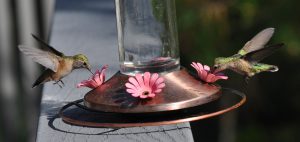Published on May 2, 2017
Midas is excited to present our Hummingbird Special Series with in-house hummingbird expert, Ken Assmus. Through this series, we will share fun facts, expert advice, fascinating photos, and more. So if you are as captivated by these amazing little creatures as we are, stay tuned!
Many people across the Pacific Northwest will begin seeing hummingbirds arrive over the next few weeks as they migrate from southern Mexico to Canada. There are five species of hummingbirds that visit Idaho during the summer to nest and raise their young.
They are very active little birds. The best-known characteristics of the hummingbird are its extremely rapid wing-beat, up to 50-80 beats per second, and its amazing ability to maneuver. It can hover in one spot by moving its wings in a figure eight motion. Hummingbirds can fly backwards, sideways and even upside down.
All this activity, of course, uses an enormous amount of energy. To keep up their blistering lifestyle, hummingbirds burn huge amounts of calories. Using all that energy, hummingbirds needs an extremely efficient fuel. They obtain this fuel in the form of nectar from flowers and consume a large quantity of small insects for protein. Up to 60 percent of their diet is insects and 40 percent is nectar from flowers and bird feeders.
This summer, you can help fuel hummingbird migration.
Hummingbird Feeder Solution: If you put out a hummingbird feeder, please make sure it is clean with no mold or bacteria growing within the feeder.
Hummingbirds love a 4:1 ratio of water to sugar. When making the solution heat the water to almost a boil, remove from heat and then stir in the sugar. Please do not add any red food dye to the solution, this is very harmful to hummingbirds and can potentially kill them.
If you have extra solution, store it in refrigerator. Change the solution in your feeder every 3-5 days. When it gets warmer outside, you should change your feeder even more frequently.
Photo credits belong to Ken Assmus


